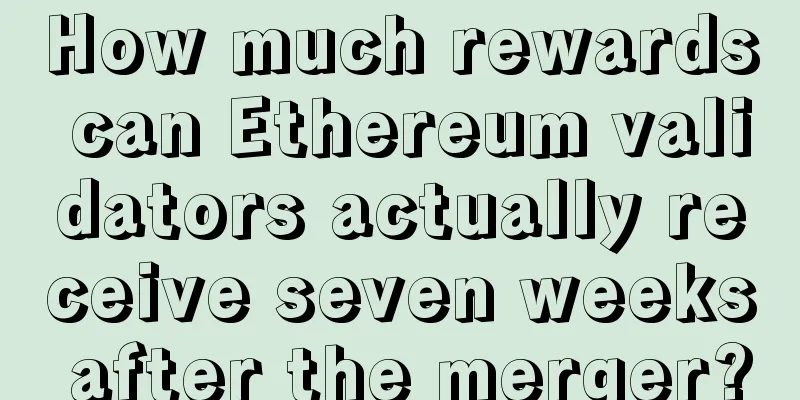How much rewards can Ethereum validators actually receive seven weeks after the merger?

|
Original text: "Ethereum Merge Scams: How Scammers Took Advantage of The Ethereum Merge to Make Millions" by ERIC JARDINE On September 15, 2022, the Ethereum merge officially took place (block height 15537394 on the execution layer and slot 4700013 on the consensus layer). Now, 6 weeks have passed since the merge, and we have also collected relevant data from 2 directions (PoS validator rewards and merge-related scams) and drawn some interesting conclusions. The actual rewards received by PoS validatorsLet’s first look at the distribution of rewards actually received by PoS validators. We can draw the following five conclusions:
Merger scams surge in SeptemberDuring the merger, scams related to the merger stole $1.2 million worth of ETH and became the main scam category in the Ethereum ecosystem. Most merger scams work in a classic way — scammers (often posing as celebrities) trick victims into sending a certain amount of cryptocurrency in order to “upgrade” to the new Ethereum blockchain and receive more in return (usually double the victim’s initial payment). The scam invites users to send 1 ETH to an address and receive 2 ETH in return. This strategy worked many times, as shown in the figure below. On the day of the Ethereum merger, the scam saw a huge spike in revenue, swindling over $905,000 worth of ETH, while all other Ethereum scams swindled less than $74,000. However, the fraud spike quickly fell back to normal levels within a few days, and scams related to the merger almost disappeared by the end of September. Merger scams accounted for eight of the top ten Ethereum scams on September 15. Surprisingly, scams related to the merger had an 83% success rate on September 15, the day of the merger, and a 100% success rate in the days before and after the merger. Such success rates also indicate that scammers are targeting users who lack knowledge about the merger. Scammers tend to defraud users in the country they live in (probably due to language barriers). In the chart below, we can see some of the countries most affected by the merger scam in September, with the second axis showing the connection to other Ethereum scams. In the chart, the United States and India have the most victims of merger scams. Merger scams also appear to target certain developed countries. Finland, for example, is surprisingly "scammed," with three scams targeting only Finland. SummarizeWith DeFi hacks dominating recent headlines, fraud using traditional tactics remains the largest form of crime in crypto. Fraud that exploits user trust will severely impact cryptocurrency adoption. Changes in the crypto industry like mergers are windows of opportunity for scammers, and users’ lack of knowledge can be exploited by bad actors. The surge in “merger”-related scams clearly shows that the blockchain industry needs to work hard to educate users on what terms such as “merger” mean and what common scams should be avoided. |
>>: CZ took over FTX but set off the real Lehman Brothers in the crypto world
Recommend
What does the short-lived man's face mean?
Everyone hopes that he or she will be healthy and...
Why is Ethereum Gas Fee Cheap Again?
Transaction costs on the top-ranked smart contrac...
What is the fortune of a woman with uneven shoulders throughout her life?
Everyone’s life is different. Some people have ev...
The number of mining attack detections increased by 96% in the first half of 2018
Trend Micro Incorporated, a global cybersecurity ...
Ethereum is at $1,500, is a new round of market coming?
Author | Hashipi Analysis TeamPrevious review: ET...
What does it mean for a girl to have a widow's peak? What is her fate?
A widow's peak refers to a pointed corner gro...
Are men with narrow eyes mean? Yes, they are mean.
Generally speaking, mean men are not very popular...
Unstoppable! Bitcoin breaks through $14,000 and rises more than 20% in one day
At about 6:00 p.m. Wednesday, U.S. time, accordin...
The countdown begins: What does Coinbase's direct listing mean for the crypto industry?
Coinbase will go public directly on the Nasdaq st...
Moles that can help you meet true love
Moles that can help you meet true love Mole on sh...
Swiss National Bank Chairman: Blockchain and distributed ledgers are disrupting the financial industry
Yesterday, Thomas Jordan, President and Chairman ...
What does it mean that if one has messy eyebrows and is worried, he will be of little use even if he has great talent?
Eyebrows can reveal a person's emotions. Of c...
A person who always likes to do small things at work
After entering the society, many people sigh abou...
What is the fate line? Destiny Line Detailed Explanation
We have many lines on our hands, including career...
How to read the face of a rich businessman's wife? The facial signs of a woman who can become a rich wife
A woman with a good fortune can marry a good man ...









